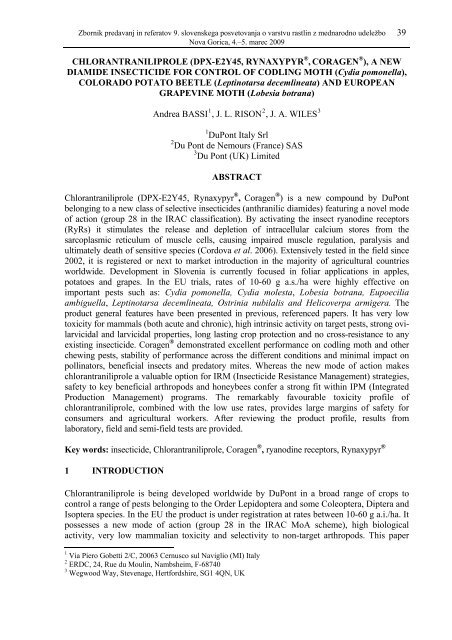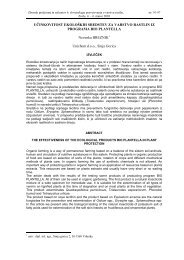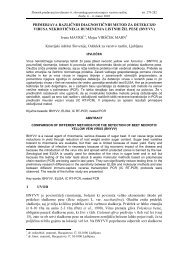Chlorantraniliprole (DPX-E2Y45, Rynaxypyr®, Coragen®) a new ...
Chlorantraniliprole (DPX-E2Y45, Rynaxypyr®, Coragen®) a new ...
Chlorantraniliprole (DPX-E2Y45, Rynaxypyr®, Coragen®) a new ...
You also want an ePaper? Increase the reach of your titles
YUMPU automatically turns print PDFs into web optimized ePapers that Google loves.
Zbornik predavanj in referatov 9. slovenskega posvetovanja o varstvu rastlin z mednarodno udeležbo 39<br />
Nova Gorica, 4.–5. marec 2009<br />
CHLORANTRANILIPROLE (<strong>DPX</strong>-<strong>E2Y45</strong>, RYNAXYPYR ® , CORAGEN ® ), A NEW<br />
DIAMIDE INSECTICIDE FOR CONTROL OF CODLING MOTH (Cydia pomonella),<br />
COLORADO POTATO BEETLE (Leptinotarsa decemlineata) AND EUROPEAN<br />
GRAPEVINE MOTH (Lobesia botrana)<br />
Andrea BASSI 1 , J. L. RISON 2 , J. A. WILES 3<br />
1 DuPont Italy Srl<br />
2 Du Pont de Nemours (France) SAS<br />
3 Du Pont (UK) Limited<br />
ABSTRACT<br />
<strong>Chlorantraniliprole</strong> (<strong>DPX</strong>-<strong>E2Y45</strong>, Rynaxypyr ® , Coragen ® ) is a <strong>new</strong> compound by DuPont<br />
belonging to a <strong>new</strong> class of selective insecticides (anthranilic diamides) featuring a novel mode<br />
of action (group 28 in the IRAC classification). By activating the insect ryanodine receptors<br />
(RyRs) it stimulates the release and depletion of intracellular calcium stores from the<br />
sarcoplasmic reticulum of muscle cells, causing impaired muscle regulation, paralysis and<br />
ultimately death of sensitive species (Cordova et al. 2006). Extensively tested in the field since<br />
2002, it is registered or next to market introduction in the majority of agricultural countries<br />
worldwide. Development in Slovenia is currently focused in foliar applications in apples,<br />
potatoes and grapes. In the EU trials, rates of 10-60 g a.s./ha were highly effective on<br />
important pests such as: Cydia pomonella, Cydia molesta, Lobesia botrana, Eupoecilia<br />
ambiguella, Leptinotarsa decemlineata, Ostrinia nubilalis and Helicoverpa armigera. The<br />
product general features have been presented in previous, referenced papers. It has very low<br />
toxicity for mammals (both acute and chronic), high intrinsic activity on target pests, strong ovilarvicidal<br />
and larvicidal properties, long lasting crop protection and no cross-resistance to any<br />
existing insecticide. Coragen ® demonstrated excellent performance on codling moth and other<br />
chewing pests, stability of performance across the different conditions and minimal impact on<br />
pollinators, beneficial insects and predatory mites. Whereas the <strong>new</strong> mode of action makes<br />
chlorantraniliprole a valuable option for IRM (Insecticide Resistance Management) strategies,<br />
safety to key beneficial arthropods and honeybees confer a strong fit within IPM (Integrated<br />
Production Management) programs. The remarkably favourable toxicity profile of<br />
chlorantraniliprole, combined with the low use rates, provides large margins of safety for<br />
consumers and agricultural workers. After reviewing the product profile, results from<br />
laboratory, field and semi-field tests are provided.<br />
Key words: insecticide, <strong>Chlorantraniliprole</strong>, Coragen ® , ryanodine receptors, Rynaxypyr ®<br />
1 INTRODUCTION<br />
<strong>Chlorantraniliprole</strong> is being developed worldwide by DuPont in a broad range of crops to<br />
control a range of pests belonging to the Order Lepidoptera and some Coleoptera, Diptera and<br />
Isoptera species. In the EU the product is under registration at rates between 10-60 g a.i./ha. It<br />
possesses a <strong>new</strong> mode of action (group 28 in the IRAC MoA scheme), high biological<br />
activity, very low mammalian toxicity and selectivity to non-target arthropods. This paper<br />
1 Via Piero Gobetti 2/C, 20063 Cernusco sul Naviglio (MI) Italy<br />
2 ERDC, 24, Rue du Moulin, Nambsheim, F-68740<br />
3 Wegwood Way, Stevenage, Hertfordshire, SG1 4QN, UK
40 Andrea BASSI et al.<br />
summarizes the main product features and provides a selection of the results obtained in the<br />
experimental work carried out in the EU on codling moth, Colorado potato beetle and the<br />
European grapevine moth since 2002. The experimental results obtained in Slovenia in 2008<br />
were consistent with those from the rest of Europe.<br />
Product Features<br />
Upon exposure, the sensitive insect species rapidly stops feeding, becomes paralyzed, and<br />
ultimately die. <strong>Chlorantraniliprole</strong> is primarily active on chewing pests by ingestion and by<br />
contact, showing good ovi-larvicidal and larvicidal activity. In Colorado potato beetle, good<br />
efficacy on adults is also observed. Inhibition of insect feeding occurs rapidly (minutes to a few<br />
hours after ingestion) and death normally occurs within 24-72 hours. Consistency of performance<br />
and long lasting crop protection are key product features. Differential selectivity towards insect<br />
ryanodine receptors (RyRs) explains the product’s outstanding profile of mammalian toxicity. The<br />
remarkably low toxicity combined with low use rates provides large margins of safety for<br />
consumers and agricultural workers (Bassi et al, 2007).<br />
Common name: <strong>Chlorantraniliprole</strong><br />
Chemical class: Anthranilic diamide<br />
Code number: <strong>DPX</strong>-<strong>E2Y45</strong><br />
Molecular formula: C18H14BrCl2N5O2<br />
DuPont Reg. trademark (active) Rynaxypyr ®<br />
DuPont Reg. trademark (20 SC formulation) Coragen ®<br />
Structural formula:<br />
H<br />
N<br />
H 3 C<br />
Cl<br />
N H<br />
O<br />
H<br />
N<br />
O<br />
CH 3 N<br />
Br<br />
N<br />
N<br />
Cl<br />
Formulations - For use on codling moth, Colorado beetle and the European grapevine moth,<br />
<strong>Chlorantraniliprole</strong> is primarily formulated as a 20% w/v (200 g /l) suspension concentrate<br />
(Coragen ® ) showing good tank-stability and compatibility with conventional crop protection<br />
products. Unless otherwise specified, the results reported in this paper refer to the Coragen<br />
formulation.<br />
Beneficial organisms - <strong>Chlorantraniliprole</strong> has an excellent profile of safety to beneficial<br />
arthropods (Dinter et al. 2008), pollinators and non-target organisms such as earthworms and soil<br />
microorganisms. The product effects on honeybees have been studied extensively, demonstrating<br />
low intrinsic toxicity of chlorantraniliprole and Coragen ® . No negative effects were observed<br />
under worst-case semi-field conditions on foraging honey bees in numerous tunnel tests (Dinter et<br />
al. 2009, in press). This is an important differentiating feature of Coragen ® compared to most<br />
synthetic pyrethroid, organo-phosphate and neonicotinoid insecticides that are currently used.<br />
Earthworm acute LC50; >1000 mg a.i./kg<br />
Earthworm reproduction NOEC: 1000 mg a.i./kg<br />
Honeybee acute (48-h) LD50 (oral) : >114 µg a.i./bee<br />
Honeybee acute (48-h) LD50 (contact) >100 µg a.i./bee<br />
Wasp parasitoid (A. rhopalosiphi) LR50 and ER50 : >750 g a.i./ha<br />
Predatory mite (T. pyri) LR50 and ER50: >750 g a.i./ha
<strong>Chlorantraniliprole</strong> (<strong>DPX</strong>-<strong>E2Y45</strong>, Rynaxypyr ® , Coragen ® ) a <strong>new</strong> diamide insecticide… 41<br />
Anti-resistance strategy - <strong>Chlorantraniliprole</strong> features a <strong>new</strong> mode of action (group 28 in the<br />
IRAC MoA scheme). Although it has no cross-resistance with other insecticidal modes of<br />
action, the risk of resistance development has been considered from the beginning. Proactive,<br />
anti-resistance management is an essential part of the marketing strategy of<br />
<strong>Chlorantraniliprole</strong>. The product will be recommended for use with a restricted number of<br />
applications per season, within spray programmes that include other effective insecticides<br />
with different modes of action.<br />
2 MATERIALS AND METHODS<br />
The European field experiments were conducted following EPPO (European & Mediterranean<br />
Plant Protection Organization) or local guidelines, in accordance with GEP (Good Experimental<br />
Practice). Treatment effects are reported as % reduction (of damage or larvae) over the<br />
untreated control using Henderson-Tilton’s, Schneider-Orelli or the Abbott’s formula. The results<br />
presented here can be split according to three different datasets:<br />
1) performance of Coragen on codling moth and European grapevine moth as a mean of all<br />
the assessments carried out season-long in all the significant European trials (2003-06)<br />
2) control of Colorado beetle from 19 highly significant trials from Eastern European<br />
countries carried out in collaboration with local Potato Institutes (2004-07).<br />
3) performance of Coragen from the trials carried out in Slovenia in 2008 on codling moth,<br />
pear leaf blister and Colorado beetle.<br />
3 RESULTS AND DISCUSSION<br />
3.1. Pome fruits – Codling moth<br />
Coragen has demonstrated outstanding codling moth control. Results from sequential<br />
applications at 14-day intervals, at 3.5-4 g a.i./hl indicate better performance than the best OP<br />
or IGR (MAC 4 ) reference products. The best comparative results are normally observed when<br />
a reduced number of sprays is applied.<br />
Table 1, Efficacy on codling moth (Europe, 2003-2006).<br />
Dose rate % Damage Reduction<br />
Treatment<br />
g a.i./hl<br />
All fruit<br />
immature<br />
fruits<br />
mature<br />
fruits<br />
fallen fruits<br />
Coragen 3.5 90 89 93 89<br />
Coragen 4 93 92 93 92<br />
Reference OP Label Rate 85 87 80 87<br />
Reference MAC Label Rate 75 75 75 74<br />
Best results were obtained when Coragen ® was applied before egg-hatch, during the<br />
embryonic stage of C. pomonella. The ovicidal timing (egg-laying to “black-head” stage)<br />
provides the best overall performance against codling moth. This is explained by the long<br />
lasting biological availability of the molecule, the partial ovicidal effects, the potent ovilarvicidal<br />
effects and the strong larvicidal activity on codling moth neonates, either by contact<br />
or ingestion.<br />
Coragen performance was validated in a field trial carried out in Slovenia in 2008 with six<br />
applications covering the 1 st and 2 nd codling moth generations. The infestation was more<br />
significant end of 2 nd generation, with 6,6 fruits infested on untreated. Coragen either alone or<br />
in an alternation program with Steward ® (Indoxacarb) provided a high control level (>90%) in<br />
the same range or higher than the standard reference programs.<br />
4 Moulting Accelerating Compound
42 Andrea BASSI et al.<br />
% infested apples<br />
7<br />
6<br />
5<br />
4<br />
3<br />
2<br />
1<br />
0<br />
0.1<br />
98<br />
CORAGEN<br />
SOLO<br />
Apple Codling Moth - Selnica ob Dravi - 2008<br />
6 APPLICATIONS: 3 APPLNS / GENERATION<br />
0.6<br />
91<br />
CORAGEN<br />
STEWARD<br />
PROGRAM<br />
0.9<br />
86<br />
1st Generation<br />
2nd Generation<br />
% Control 2nd Gen<br />
STANDARD IGR<br />
(MAC)<br />
0.7<br />
90<br />
STANDARD<br />
OP<br />
0.3<br />
95<br />
STANDARD AREA<br />
PROGRAM<br />
2.7<br />
6.6<br />
0<br />
Untreated<br />
Fig. 1: Results of apple codling moth trial, Selnica ob Dravi, 2008 (Courtesy of the Agricultural and Forestry<br />
Chamber of Slovenia).<br />
3.2. Pome fruits - Leafminers<br />
In the European trials Coragen has demonstrated strong activity on the different leafminer<br />
species affecting the pome fruits when applied during the egg-laying, before the mines are<br />
visible on leaves. In a trial carried out in Slovenia in 2008 on the pear leaf blister moth<br />
(Leucoptera scitella), with two applications targeting the 1 st leafminer generation, Coragen ®<br />
provided the same efficacy level as the neonicotinoid standards.<br />
% dead larvae<br />
100<br />
90<br />
80<br />
70<br />
60<br />
50<br />
40<br />
30<br />
20<br />
10<br />
0<br />
93.0<br />
CORAGEN<br />
SOLO<br />
Leucoptera scitella - Bresternica near Maribor - 2008<br />
TWO APPLICATIONS:1 APPLN/GENERATION<br />
88.1<br />
STANDARD<br />
NEONIC 1<br />
39.8<br />
% dead larvae<br />
% corrected efficacy<br />
STANDARD<br />
BIOLOGICAL<br />
88.4<br />
STANDARD<br />
NEONIC 2<br />
0.0<br />
Untreated<br />
0<br />
120<br />
100<br />
80<br />
60<br />
40<br />
20<br />
0<br />
100<br />
90<br />
80<br />
70<br />
60<br />
50<br />
40<br />
30<br />
20<br />
10<br />
% control 2nd gen<br />
% corrected efficacy<br />
(Scheider-Orelli)<br />
Fig. 2: Results of pear blister moth trial, Bresternica near Maribor, 2008 (Courtesy of the Agricultural and<br />
Forestry Chamber of Slovenia).
<strong>Chlorantraniliprole</strong> (<strong>DPX</strong>-<strong>E2Y45</strong>, Rynaxypyr ® , Coragen ® ) a <strong>new</strong> diamide insecticide… 43<br />
3.3 Potato – Colorado potato beetle<br />
The results from 32 European trials show that low rates of Rynaxypyr ® provided excellent control<br />
of L. decemlineata for up to 22 days after a foliar application. 10 g a.i./ha (Coragen at 50 ml/ha)<br />
gave better control than pyrethoid insecticides and the same control as the neonicotinoid<br />
standards. Table 2 reports the mean performance from all the assessments carried out 1 to 22 days<br />
after single applications.<br />
Table 2: Efficacy on L. decemlineata 1-22 days after 1 application (Europe 2003-2006).<br />
Treatment<br />
Dose rate,<br />
g a.i./ha<br />
% Reduction<br />
foliar damage<br />
% Reduction<br />
larvae<br />
Coragen 10 89 92<br />
Coragen 12.5 91 97<br />
Reference S. Pyrethroid Label Rate 75 84<br />
Reference Neonicotinoid Label Rate 89 93<br />
Seemingly, the results from a set of 19 trials carried out in the Eastern Europe in collaboration<br />
with the local Potato Institutes, confirmed excellent performance in the rate range 10-12.5 g<br />
a.i./ha. In some trials Coragen demonstrated longer lasting beetle control vis-à-vis the local<br />
neonicotinoid standard, as reflected in the assessments carried out 21 days after application<br />
(Bassi et al., 2008).<br />
% Efficacy<br />
on larvae<br />
(L1-L4)<br />
100<br />
50<br />
Coragen ® on L. decemlineata in Eastern Europe*<br />
Mean of 19 trials (2004-07) - Beetle control 3 to 21 DAA<br />
96 98 91 98<br />
94 98 97<br />
91 96 93 93<br />
0<br />
2-3DAA 5-7DAA 14-15DAA 21DAA<br />
<strong>Coragen®</strong> (50 ml/ha) 91 96 93 93<br />
<strong>Coragen®</strong> (60-62.5 ml/ha) 94 98 97 98<br />
Neonics (label rates ) 96 98 91 78<br />
78<br />
Neonics (label rates)<br />
<strong>Coragen®</strong> (60-62.5 ml/ha)<br />
<strong>Coragen®</strong> (50 ml/ha)<br />
*Ukraine (4), Belarus (1), Hungary (4),<br />
Rumania (4), Serbia (2), Poland (4)<br />
Fig. 3: Mean results of 19 Colorado potato beetle trials carried out in Eastern European countries (2004-2007)<br />
in collaboration with the local Potato Institutes.<br />
Longer lasting crop protection was also observed in a validatory field trial carried out in<br />
Slovenia in 2008, with one application at first larvae appearance. Coragen at both tested rates<br />
provided a high control level 20 DDA, significantly higher than the reference neonicotinoid<br />
products.
44 Andrea BASSI et al.<br />
% Efficacy<br />
on Larvae<br />
Coragen ® on L. decemlineata - Livelice by Dravograd (SL)<br />
Beetle control 3 to 20 DAA (2008)<br />
100<br />
50<br />
0<br />
98<br />
96<br />
98<br />
88<br />
99<br />
72<br />
84<br />
Neonic 1 (label rate) 98 88 43<br />
Neonic 2 (label rate) 96 72 52<br />
<strong>Coragen®</strong> (50 ml/ha) 98 84 98<br />
<strong>Coragen®</strong> (60 ml/ha) 99 92 99<br />
43<br />
3 DAA 9 DAA 20 DAA<br />
92<br />
52<br />
98<br />
99<br />
Neonic 2 (label rate)<br />
Neonic 1 (label rate)<br />
<strong>Coragen®</strong> (60 ml/ha)<br />
<strong>Coragen®</strong> (50 ml/ha)<br />
Fig. 4: Results of Colorado potato beetle trial, Libeliče by Dravograd, 2008. Courtesy of the Slovenian Institute<br />
for Hop Research and the Brewing.<br />
3.4 Grapes – European grapevine moth<br />
Coragen ® was broadly tested on wine and table grapes in Southern and Central Europe for control of the<br />
grape berry moths. On Lobesia botrana, 3-3,5 g a.i./hl provided a comparable or higher reduction of fruit<br />
damage and larval presence over commercial standards. For best results, Coragen should be applied early,<br />
before egg-hatch (egg-laying to “black-head” stage). Similar results were obtained for control of Eupoecilia<br />
ambiguella.<br />
nd<br />
Table 3: Efficacy on 2 generation Lobesia botrana (Europe 2003-2006).<br />
% Reduction<br />
Treatment g a.i./hl<br />
damaged<br />
bunches<br />
damaged<br />
berries<br />
larvae<br />
Coragen 2.5 73 86 87<br />
Coragen 3 78 90 92<br />
Coragen 3.5 80 89 96<br />
Reference MAC Label Rate 61 85 91<br />
4 CONCLUSIONS<br />
The results from the extensive field testing of Coragen ® in Europe (2002-2008) demonstrated high biological<br />
activity and long lasting crop protection as regards the apple codling moth (Cydia pomonella), Colorado<br />
potato beetle (Leptinotarsa decemlineata) and the European grapevine moth (Lobesia botrana). Such results<br />
were confirmed in the field trials carried out in 2008 in Slovenia, in cooperation with the Pinus company, the<br />
Agricultural and Forestry Chamber of Slovenia and the Slovenian Institute for Hop Research and the<br />
Brewing. Coragen is already registered in several countries worldwide and next to registration in all the main<br />
agricultural countries in Europe. Due to the exceptional toxicological profile of Rynaxypyr ® , the European<br />
MRL’s (maximum residue limits) have already been issued and entered into force on Sep. 1, 2008. As
<strong>Chlorantraniliprole</strong> (<strong>DPX</strong>-<strong>E2Y45</strong>, Rynaxypyr ® , Coragen ® ) a <strong>new</strong> diamide insecticide… 45<br />
Rynaxypyr ® has proven to be safe to numerous beneficial arthropods and pollinators, i.e. honeybees and<br />
bumblebees, Coragen will be an excellent tool in integrated pest management (IPM) programs.<br />
5 REFERENCES<br />
Bassi A., Molnar I., Zielinski D., Savulescu I., Shulgan V., Denic I., Allin J. & Rison J.L. <strong>Chlorantraniliprole</strong> (Rynaxypyr ® ,<br />
Coragen ® ): a novel anthranilic diamide insecticide with outstanding control of Colorado Potato Beetle (Leptinotarsa<br />
decemlineata). Proceedings of the 17th Triennial Conference of the EAPR – International Potato Conference, 475-<br />
478<br />
Bassi A., Alber R., Wiles J.A., Rison J.L., Frost N.M., Marmor F.W., Marcon P.C., 2007. <strong>Chlorantraniliprole</strong>: a novel<br />
anthranilic diamide insecticide. Proceedings of XVI International Plant Protection Congress 2007, Vol. 1:52-59.<br />
Cordova D., Benner E.A., Sacher M.D., Rauh J.J., Sopa J.S., Lahm G.P., Selby TP; Stevenson T.M., Flexner L.,<br />
Gutteridge S., Rhoades D.F., Wu L., Smith R.M., Tao Y., 2006. Anthranilic diamides: A <strong>new</strong> class of insecticides with<br />
a novel mode of action, ryanodine receptor activation. Pesticide Biochemistry and Physiology, 84, 196-214A.<br />
Dinter A., Brugger K., Bassi A., Frost N.M. & Woodward M.D. (2008). <strong>Chlorantraniliprole</strong> (<strong>DPX</strong>-<strong>E2Y45</strong>, Rynaxypyr ® )<br />
(Coragen ® 20SC and Altacor ® 35WG) – a novel DuPont anthranilic diamide insecticide – demonstrating low toxicity<br />
and low risk for beneficial insects and predatory mites. IOBC WPRS Bulletin, 35: 128-135





